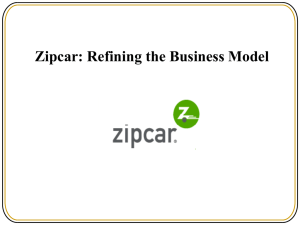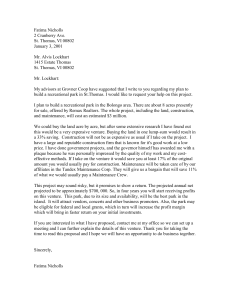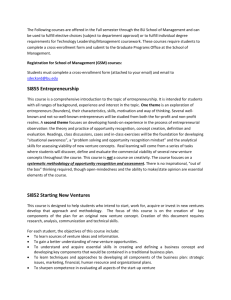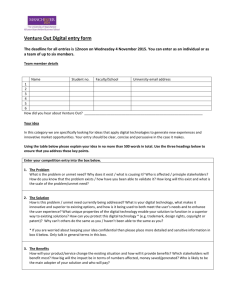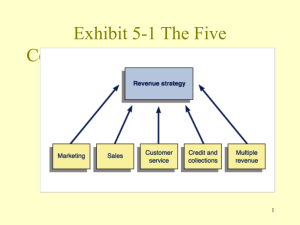University of Delaware
advertisement
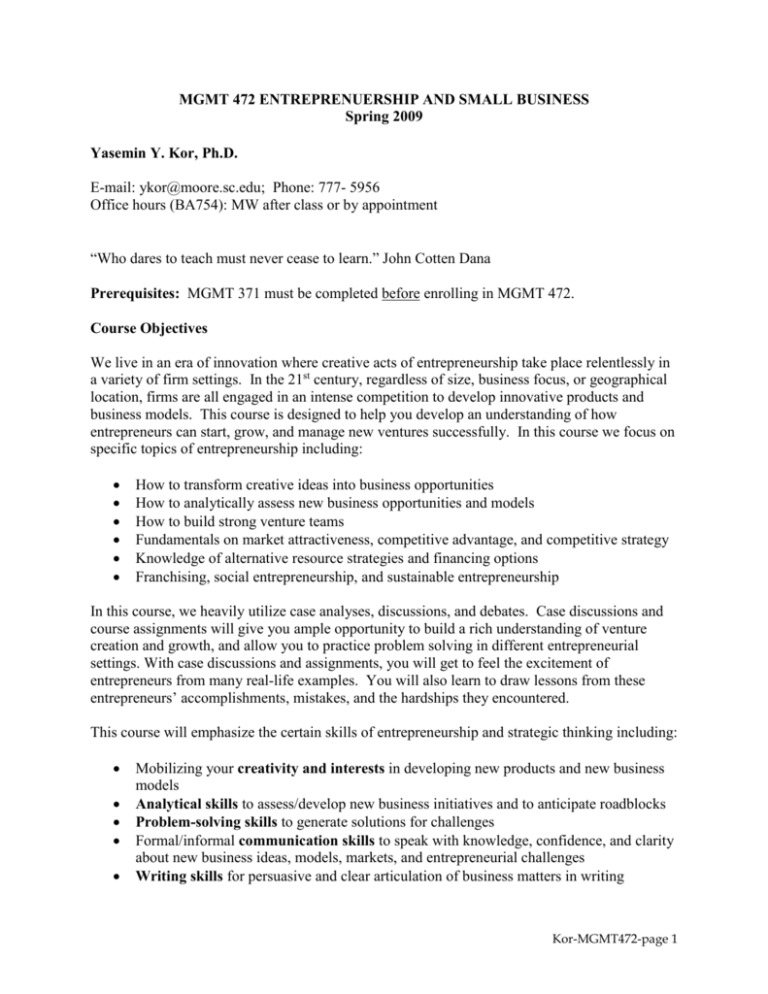
MGMT 472 ENTREPRENUERSHIP AND SMALL BUSINESS Spring 2009 Yasemin Y. Kor, Ph.D. E-mail: ykor@moore.sc.edu; Phone: 777- 5956 Office hours (BA754): MW after class or by appointment “Who dares to teach must never cease to learn.” John Cotten Dana Prerequisites: MGMT 371 must be completed before enrolling in MGMT 472. Course Objectives We live in an era of innovation where creative acts of entrepreneurship take place relentlessly in a variety of firm settings. In the 21st century, regardless of size, business focus, or geographical location, firms are all engaged in an intense competition to develop innovative products and business models. This course is designed to help you develop an understanding of how entrepreneurs can start, grow, and manage new ventures successfully. In this course we focus on specific topics of entrepreneurship including: How to transform creative ideas into business opportunities How to analytically assess new business opportunities and models How to build strong venture teams Fundamentals on market attractiveness, competitive advantage, and competitive strategy Knowledge of alternative resource strategies and financing options Franchising, social entrepreneurship, and sustainable entrepreneurship In this course, we heavily utilize case analyses, discussions, and debates. Case discussions and course assignments will give you ample opportunity to build a rich understanding of venture creation and growth, and allow you to practice problem solving in different entrepreneurial settings. With case discussions and assignments, you will get to feel the excitement of entrepreneurs from many real-life examples. You will also learn to draw lessons from these entrepreneurs’ accomplishments, mistakes, and the hardships they encountered. This course will emphasize the certain skills of entrepreneurship and strategic thinking including: Mobilizing your creativity and interests in developing new products and new business models Analytical skills to assess/develop new business initiatives and to anticipate roadblocks Problem-solving skills to generate solutions for challenges Formal/informal communication skills to speak with knowledge, confidence, and clarity about new business ideas, models, markets, and entrepreneurial challenges Writing skills for persuasive and clear articulation of business matters in writing Kor-MGMT472-page 1 COURSE REQUIREMENTS AND GRADING (100 Points) (1) (2) (3) (4) 20 points 20 points 20 points 40 points Active Participation in Case Discussions and Exercises Group Case Write-up Group Case Presentation Exam I and Exam II (20 points each) To complete this course, you will prepare individual and group assignments and participate in case discussions and lectures. You are responsible for all assignments that are in the syllabus (whether or not I remind you of them). Also, everything needs to be turned in on time. REQUIRED TEXT: Custom Textbook (available through University Bookstore) I reserve the right to hand out additional material or to place additional material in the library. BIBLIOGRAPHY OF CASES 1. 2. 3. 4. 5. 6. 7. 8. 9. 10. 11. Roxanne Quimby: Burt’s Bees Jim Poss: Seahorse Power Co. Starbucks Peanut Butter Fantasies Icedelights Hickory Ridge Golf Club Digital Data Divide WholeFoods Market, Inc. Ben & Jerry’s and Unilever ZipCar Nantucket Nectars Personal Care Products Industry Solar Trash Compactor Business Gourmet Coffee (Retail) Industry Gourmet Food Industry Ice Cream Franchise Golf Club Industry IT Industry/Social Entrepreneurship Supermarket Industry Ice Cream/Social Entrepreneurship Car Sharing Industry Beverage Industry POLICY ON CLASS ETIQUETTE You are required to attend class on time. When you come to class late, you reduce the quality of instruction and the presentations since everyone is distracted as you enter the class. Coming to class late will affect your participation grade adversely. Cell phones should be turned off during class. Laptops are to be used for class activities only. If you are seen net surfing or e-mailing during a class session you lose laptop privileges for the remainder of the course. POLICY ON CHEATING No form of cheating is allowed. I encourage you to become familiar with the University’s Honor Code found in the Official Student Handbook available on the Web at: http://www.sc.edu/academicintegrity/honorcode.html Kor-MGMT472-page 2 (1) PARTICIPATION IN CASE DISCUSSIONS AND EXERCISES (20 points) A successful business career requires speaking with knowledge, confidence, and clarity on business ideas, models, markets, and strategic issues. Active participation in case discussions will give you ample opportunity to practice these essential business communications skills. Your participation grade will be based on your verbal comments and contributions during case discussions and exercises. Please note that meaningful participation requires close reading and thorough preparation of each case. Your participation grade is earned through consistent, quality comments throughout the semester. The participation ratings are to be based on both the quantity and quality of contributions. Evaluation criteria for participation include: Do your points reflect creative and analytical interpretations of key information and insights from the case? Do they provide new insights? Do your comments reflect in-depth analysis and application of tools and concepts learned in this and other classes? Are comments/questions thought-provoking and do they spark new conversations/debates? Each case or lecture topic addresses a different set of strategic issues. To help guide your thinking and analysis for each case or topic, please refer to the case and chapter Discussion Questions provided in this syllabus under Course Sessions (starting on page 6). In preparing for a particular class, please review and develop answers for these discussion questions. Take notes when you read/analyze the case and then use them during class discussions. Always keep in mind that your class preparation cannot be evaluated if you do not volunteer comments. If you don’t participate in discussions throughout the semester, your participation grade will be zero. Attendance does not count as participation. I expect each student to participate every class by making meaningful comments that involves analysis, interpretation, and/or evaluation of the case facts and issues. High quality participation also means being constructive and helping move the class discussion forward. Disagreeing with the comments of your classmates is expected, as long as you are constructive about it. Also, do not refrain from participating for the fear of being wrong. Your verbal participation will be supplemented with 1-page case write-ups that you will prepare throughout the semester (a total of six write-ups). In these case write-ups, you will answer specific questions to be provided by the instructor. Write-ups are due at the beginning of the class. In preparing your write-ups, use 12-font, single-space, and 1-inch margins on all sides. A useful advice from your instructor: Do not disengage when group presentations start. I continue grading participation. Be attentive and stay engaged by asking presenters thoughtprovoking questions and offering comments during the Q&A. The first day of class I will take your pictures to learn your names. If you miss this particular class, it is your responsibility to bring me a copy of a recent photo. I have an open-door policy, so please keep in touch with me regarding your participation grade anytime during the semester. Kor-MGMT472-page 3 (2) GROUP CASE WRITE-UP (20 points) INSTRUCTIONS: Executive Summary (first page): In one page, discuss the most critical issues faced by Hickory Ridge Golf Club. Also, provide a summary of your recommendations. Analysis: I. Customer Analysis: How does Hickory Ridge satisfy the first two anchors of good opportunity? What are the needs/wants of golf players? Who are the golf players? Who are Hickory’s target customers? How is Hickory delivering value to its customers? Do Hickory’s customers have any unmet needs or frustrations (speculate when necessary)? How well do you think Hickory’s customers satisfied? II. Evaluate the Financial Health of Hickory. What are the weak spots in Hickory’s income statement and balance sheet? How can they be improved? (Exhibits 1, 2, & 3; In Exhibit 3, look at both 1988 and 1989) III. What are the Growth Opportunities for Hickory? Discuss general golf trends and local factors that influence demand for golf courses. Also identify revenue opportunities (Exhibit 3). IV. Evaluate Competitive Threats for Hickory. Who are Hickory’s direct competitors (considering location and other public courses)? How does Hickory fare compared to its competitors in pricing? How about in golf course quality, snack bar-shop quality, etc.? Should Hickory worry about other competitors as well? Why, why not? V. What are Hickory’s Operational Problems (i.e., issues regarding running the golf course on a day to day basis)? Identify, briefly discuss different problems (do not summarize the case!) Rank order issues in terms of importance. Group issues as high, medium, and low priority issues (i.e., importance or urgency for the issue to be addressed or fixed) and discuss your reasoning for this grouping. Discuss costs and benefits of the solving these problems. See the next page for further instructions Kor-MGMT472-page 4 Recommendations: (Save 2-3 pages for recommendations!) VI. What are Hickory’s options? What are your Recommendations? Discuss in detail. Should Hickory use the golf course as a cash cow (with no capital improvements)? Should Hickory fix all of the operational problems? Should Hickory fix a subset of the problems, and what would they be? Explain in detail. Provide a cost-benefit analysis if you recommend that Hickory makes capital improvements? Provide and show with calculations the estimated payback period. Also discuss how the investments would be financed. Should Hickory consider changes in its pricing strategy? Should Hickory make any changes in its financing strategy? (Are they undercapitalized and over-leveraged?) Does Hickory need any changes in management & personnel? Are there other changes you recommend? Style and Format: Case write-ups should be typed using double spacing, 12-point font, and one-inch margins on all sides. Please do not use fancy report covers. Stapling is sufficient. However, the write-up should have a simple cover sheet with group number and group members’ names. Insert page numbers. The write-up should be around 10-12 pages, double-spaced (including cover, executive summary, and financial analysis). It should not exceed 14 pages. If it does, you have summarized the case, go back and refocus. Example Division of Labor Executive Summary (Person 5) Customer Analysis (Person 1) Financial Health (Person 2, Person 4) Competitive Threat (Person 3, Person 4) Growth Trends and Opportunities (Person 1) Operational Problems (Person 2, Person 3) Recommendations (incl. financial analysis) (Person 1, Person 2, Person 3, Person 4, Person 5) Late Papers: Late papers will receive a deduction of two letters grade from the grade they would have received had they been on time. That means a late paper can receive a grade no higher than a C. Late papers are accepted only within 7 days following the original deadline. Kor-MGMT472-page 5 (3) GROUP CASE PRESENTATION (20 points) The objective of these presentations is to enhance your ability to: Identify and critically analyze the issues in the case Present your analysis and specific recommendations in a persuasive style Utilize visual aids to support the presentation Think on your feet while interacting with the audience Specific assignment of cases to groups is shown below. You will have 30 minutes for the presentation (not including the Q&A session). Your group will have the primary responsibility for presenting the case. Therefore, you should: Define the strategic issue(s) Conduct an in-depth analysis of the case Develop specific recommendations Provide an update on the case firm. (The firm’s strategic directions, products, achievements, struggles, etc. since the case ~ approx. 3-4 slides) For the update, do not exclusively rely on company website. Use USC library online databases (e.g., Business Source Premier, Small Business Resource Center, Lexis Nexis) to find articles about the firm (published after the case date). Submit two articles you used for the update. At the end of the presentation, the group will answer the questions from class and the instructor. I will take the rest of the class time for discussion about the case. The specific aspects of the case your group is expected to analyze are provided in class sessions. Evaluation Criteria: - Substance of Presentation - Use of visual aids: Clarity, readability, organization - Persuasiveness: Credibility, eye contact - Management of time - Equal division of presentation material - Ability to answer questions, think on feet Total 15.00 points 1.00 points 1.00 points 1.00 points 1.00 points 1.00 points 20.00 points CASE PRESENTATION ASSIGNMENTS Groups Case 1 2 3 4 5 6 7 Peanut Butter Fantasies IceDelights Digital Divide Data Whole Foods Market, Inc. Ben & Jerry’s and Unilever Zipcar Nantucket Nectars Kor-MGMT472-page 6 Important Requirements and Tips for Case Presentation: A paper copy of all transparencies and exhibits must be provided to me before the presentation. Failure to do so will result in loss of 0.5 points. Power Point handout prints (3 slides per page) are sufficient. Use of POWER POINT (for overheads, charts) is required. Use the similar font type and background in all overheads. All members of a group are expected to participate equally in the presentation. That means each member should do same amount of work and use equal time to present. Presenters should avoid merely reading out presentation material. You can use note cards, but reading from your notes sentence by sentence is not appropriate. Presentations are professional. Please wear business or business casual attire. Do not spend too much time reviewing company history. Focus on the current and future issues, and discuss company’s history only when it is relevant to the current/future strategy and to your specific recommendations. Highly Recommended Option: If you want to get developmental feedback on your presentation, email me your group presentation file 3-4 days before the presentation day. I will reply back and send my comments and suggestions to you within two days, which should leave you another day or two to fix the problems and improve your presentation. In the past, the groups which took advantage of this opportunity did much better in their presentations. So, I am happy to make this option available to you. All group members should contribute to recommendations. Delegating recommendations to one person is like a team of detectives pursuing different cues and putting a member in charge of solving the murder mystery without any field work and evidence. Please note that your grade on the group presentation will be a group grade. If there are any free riding problems, first talk to your group about them. The group should communicate openly and professionally with the non-contributing members and let them be aware of the situation. If the problem persists, let me know about it. I will ask the group to evaluate contributions of every member. Strong negative feedback from group members results in reduction in a student’s presentation grade. This principle applies to all group assignments. (4) EXAMS I AND II (20 points each) The exam will be closed book/notes. Exams will entail questions that will require an understanding of the concepts and tools taught in class. Exams will also ask you to apply these concepts and tools to analyze and solve the problems presented in cases. Thus, it is highly recommended that you attend class regularly and take notes during lectures and case discussions. Kor-MGMT472-page 7 COURSE SESSIONS --------------------------------------------------------------------------------------------------------------------SESSION #1 Jan 12 Monday Introduction (Lecture 1) -------------------------------------------------------------------------------------------------------------------- Introduction to the course and syllabus Students forming their groups (for projects and presentation) Student pictures are taken --------------------------------------------------------------------------------------------------------------------SESSION #2 Jan 14 Wednesday --------------------------------------------------------------------------------------------------------------------Group Survival Exercise --------------------------------------------------------------------------------------------------------------------No Class on Monday Jan 19 – Martin Luther King Day --------------------------------------------------------------------------------------------------------------------SESSION #3 Jan 21 Wednesday Entrepreneurial Mind (Lecture 2) --------------------------------------------------------------------------------------------------------------------Read: Chapter 1 The Entrepreneurial Mind: Crafting a Personal Entrepreneurial Strategy Discussion questions: Before reading the assigned chapters, how would you answer the question of “what are the most important attributes of successful entrepreneurs?” What are the dominant themes that Chapter 1 identifies as attributes of successful entrepreneurs? Why do they matter? What is meant by the apprenticeship concept, and why is it so important to young entrepreneurs? What are the implications of Exhibit 1.8? What are the implications of what you read in these chapters for your career and future? How do you stack up against the six entrepreneurial mindsets? What do you need to develop and improve? Kor-MGMT472-page 8 --------------------------------------------------------------------------------------------------------------------SESSION #4 Jan 26 Monday Case: Roxanne --------------------------------------------------------------------------------------------------------------------Read: Case Roxanne Quimby (p. 46) Discussion questions: Visit www.burtsbees.com What were the factors that contributed to early success of Burt’s Bees? How much of this success was attributed to Roxanne Quimby? What were some of her strengths and weaknesses as an entrepreneur? Why is Roxanne considering to move her business to North Carolina? Why is location so important? How important is it to grow the business beyond $ 3million? What will she be giving up? How will the products be positioned and differentiated in the “new” company? Was moving to North Carolina the right choice? What are her options now? What should she do? What have you learned from this case? --------------------------------------------------------------------------------------------------------------------SESSION #5 Jan 28 Wednesday Entrepreneurial Opportunity & Venture Team (Lecture 3) --------------------------------------------------------------------------------------------------------------------Read: Chapter 8 The New Venture Team Discussion questions: Why should entrepreneurs think big? How can you identify new business opportunities? What type of changes in the environment should entrepreneurs take notice? When does an entrepreneurial idea also constitute a solid business opportunity? What are attributes of high potential opportunities in contrast to low potential opportunities? Why is the venture team so important in entrepreneurial process? What is meant by team philosophy and attitudes? Why do they matter? What are the most critical issues a lead entrepreneur should consider regarding the entrepreneurial team? What are some of the common pitfalls in team building? What are the critical rewards, compensation, and incentive issues in putting a team together? Why are these so crucial and difficult to manage? How does the lead entrepreneur allocate stock ownership and options in the new venture? --------------------------------------------------------------------------------------------------------------------- Kor-MGMT472-page 9 --------------------------------------------------------------------------------------------------------------------SESSION #6 Feb 2 Monday Case: Jim Poss --------------------------------------------------------------------------------------------------------------------Read: Case Jim Poss (p.70) Discussion questions: Visit www.bigbellysolar.com/ What is Jim’s product/business idea? How does this product deliver value? What problems does it solve? Are the benefits to the customer identifiable, repeatable, and verifiable? Is the payback to customer less than one year? Is this a high potential opportunity? Outline different work experiences Jim Poss have had over the years. What types of skills and network ties has he developed? What are Jim’s interests and educational background? Is there a good fit between the entrepreneur and the business idea? What are different entrepreneurial qualities of Jim Poss? How does he compare to Roxanne Quimby? What is a provisional patent? Why is patenting so essential? How did Jim get his first customer? How did he get feedback? How good are the growth/profitability prospects of this opportunity? What additional markets should Jim consider to boost sales? What have you learned from this case? --------------------------------------------------------------------------------------------------------------------SESSION #7 Feb 4 Wednesday Market Analysis and Financial Attractiveness (Lecture 4) --------------------------------------------------------------------------------------------------------------------Read: Chapter 3 The Entrepreneurial Process Discussion questions: How do we assess market attractiveness? What is Porter’s Five Forces Industry Analysis? What are the Five Forces? What are entry barriers? What are the conditions that elevate the bargaining power of suppliers? What are the conditions that elevate the bargaining power of buyers? What are the conditions that elevate the level of rivalry in the industry? What are the conditions that elevate the threat of substitutes? How can firms position themselves creatively against the threatening industry conditions? Can you think of several examples? How do we assess financial attractiveness of a new venture? What are key profitability ratios and what do they mean? Kor-MGMT472-page 10 --------------------------------------------------------------------------------------------------------------------SESSION #8 Feb 9 Monday Case: Starbucks Coffee --------------------------------------------------------------------------------------------------------------------Read: Case Howard Schultz and Starbucks Coffee (p.98) Discussion questions: Visit http://www.starbucks.com/ In the early 1980s, how did Howard Schultz view the possibilities for the hatching specialty coffee market? Which emerging trends and opportunities did catch his attention? What were the critical drivers of Starbucks’ success? What are the contributions of different business functions to Starbucks’ entrepreneurial success (e.g., product features, delivery/company-owned stores, positioning-branding, human resources, and operations and quality control)? Is Starbucks’ competitive advantage sustainable? What are biggest challenges of Starbucks? How should the company cope with them? What have you learned from this case? --------------------------------------------------------------------------------------------------------------------SESSION #9 Feb 11 Wednesday Franchising (Lecture 5) --------------------------------------------------------------------------------------------------------------------Discussion questions: How is franchising different from new venture creation? What are the expectations of the franchisor and franchisee? Are all franchise businesses the same? If not, how do they differ? Is there a perfect franchise opportunity? What are the key success factors? What are some of the common problems? Do you know anyone who owns a franchise? Do franchise owners work more or less hard than a “stand alone” entrepreneur? -------------------------------------------------------------------------------------------------------------------- Kor-MGMT472-page 11 -------------------------------------------------------------------------------------------------------------------SESSION #10 Feb 16 Monday Case: Peanut Butter Fantasies --------------------------------------------------------------------------------------------------------------------Read: Case Peanut Butter Fantasies Discussion questions: Visit www.pbloco.com What are the most pressing problems Peanut Butter Fantasies faces? What are some of the important barriers to entry in the peanut butter industry ( see Lecture 4)? What is the nature of the competitive advantage shared by the Big Three peanut butter producers? Could PBF have been successful in specialty stores? What else could PBF have done to be more successful in this distribution channel? Why did PBF switch to supermarkets? Was this the right move? What is PBF’s current financial condition? What credibility does Thibodeau have with investors? Is PBF going to make it? GROUP 1 -- Presentation Instructions: Read pages 6-7 of the syllabus. Briefly introduce PBF, its business, and management team. What does PBF deliver value to customers? What are the strengths and weaknesses of the venture team (especially the founder and Pepin)? Finally, in a slide or two outline and briefly introduce the most pressing problems they are facing at the time of the case. Analyze and discuss Market Potential in the Peanut Butter Industry. How big is the PB specialty market in sales and gross margins? How big is the PB supermarket sales and gross margin? Also, using Porter’s Five Forces (Lecture 4), identify specific types of barriers to entry and discuss them by giving examples and numbers from the case. Using Porter’s Five Forces (Lecture 4), analyze the threat of buyers in the peanut butter industry—that is, distributors and customers. Then, analyze and evaluate how PBFs distribution strategy evolved and where they stand now. Finally, discuss the threat of rivalry. In the current format, is this a financially viable and sustainable business opportunity? Analyze Exhibits 9 and 10. Why is PBF unprofitable? What are the cost drivers? What needs to be changed to make this company profitable? Is it possible? What are PBF’s strategic options? What do you recommend to the founder? How can PBF creatively position itself in this tough industry? Be sure to use exhibits at the end of the case (especially the numbers). Visit www.pbloco.com Kor-MGMT472-page 12 --------------------------------------------------------------------------------------------------------------------SESSION #11 Feb 18 Wednesday --------------------------------------------------------------------------------------------------------------------Career Day – No Class --------------------------------------------------------------------------------------------------------------------SESSION #12 Feb 23 Monday Case: IceDelights --------------------------------------------------------------------------------------------------------------------Read: Case IceDelights Discussion questions: Is IceDelights opportunity a good one? Evaluate the attractiveness of the deal and the Florida market. What are the critical risks faced by the business? What are the critical risks faced by each individual entrepreneur? Is there a good fit between the team and the business opportunity? If you were attracted to this franchise, what would you do differently (e.g., deal negotiation, market research, team building, financing, etc)? What are your recommendations? GROUP 2 Presentation Instructions: Read pages 6-7 of the syllabus. Briefly introduce the business idea, and discuss the challenges faced by the venture team at the time of the case. What is the IceDelights opportunity? Is it a low potential or high potential opportunity? Evaluate the attractiveness of the deal and the Florida market. (Review Lecture 3 & Lecture 4 notes) What are the critical risks involved in getting into this franchise operation? (use Exhibit 11.2 from Franchising class notes – Lecture 5). What are the critical risks faced by individual entrepreneurs? Is there a good fit between the team and the business opportunity? (Review class notes for Lecture 3) How would you evaluate their efforts to obtain capital? If you were attracted to this franchise, what would you do before you commit to the venture? How differently would you handle negotiations about the deal, market research (about the product and local conditions), team building, and financing? What are your recommendations to the current venture team? Be sure to use exhibits at the end of the case (especially the numbers). Kor-MGMT472-page 13 --------------------------------------------------------------------------------------------------------------------SESSION #13 Feb 25 Wednesday Resources (Lecture 6) --------------------------------------------------------------------------------------------------------------------Discussion questions: What are the most important resources a new venture will need? What is bootstrapping? Why is it better to work with less capital and use staged financing? What are some of the useful approaches to acquiring resources, such as people resources, capital, and other assets? What are the important issues in selection and effective utilization of outside professionals (e.g., board members, lawyers, accountants, and consultants)? What are different types of resources and capabilities that firms use to create competitive advantage? When does a firm generate sustainable profits? What are different types of business level strategies? What are requirements of low-cost strategy? What are requirements of differentiation strategy? -------------------------------------------------------------------------------------------------------------------SESSION #14 March 2 Monday --------------------------------------------------------------------------------------------------------------------- ****** EXAM I ***** --------------------------------------------------------------------------------------------------------------------SESSION #15 March 4 Wednesday Creativity Exercise – Part I --------------------------------------------------------------------------------------------------------------------Enjoy the Spring Break --------------------------------------------------------------------------------------------------------------------SESSION #16 March 16 Monday Creativity Exercise – Part II --------------------------------------------------------------------------------------------------------------------- Kor-MGMT472-page 14 --------------------------------------------------------------------------------------------------------------------SESSION #17 March 18 Wednesday Case: Digital Divide Data --------------------------------------------------------------------------------------------------------------------Read: Case Digital Divide Data: A Social Enterprise in Action Discussion questions: Visit www.digitaldividedata.com/ What is Jeremy (and the company) trying to achieve? Is Digital Divide Data successful? Is it successful socially? Is Digital Divide Data financially sustainable? How can they achieve a stronger/more stable financial position? What should the company do strategically (identify and evaluate different options)? What should Jeremy do? What have you learned from this case? GROUP 3 -- Presentation Instructions: Read pages 6-7 of the syllabus. Briefly introduce DDD and the strategic issues facing the company. Is DDD successful socially? Analyze and evaluate (their goals, activities, and achievements). Evaluate the strengths and weaknesses of DDD’s management team (Lecture 2). Also evaluate their human resources policies and operational efficiency. Is DDD successful financially? Analyze and evaluate DDD’s financial strengths and weaknesses (use Exhibit 1 and Exhibit 4). Discuss competitive trends and industry developments, and evaluate whether DDD’s business model and social objectives are sustainable in the future (Lectures 4 & 6). Identify and discuss the entrepreneurial options for DDD. How can DDD protect its decreasing profit margins (given the competitive pressures)? What are other higher margin types of works can DDD get into? What are other entrepreneurial education initiatives they pursue in Cambodia? How can DDD boost its profitability? Should DDD build an IT business with for-profit orientation? Should DDD continue to grow in Cambodia or expand internationally? Was expand into Laos a right move for DDD? Should they stop growing for a while? What are your specific recommendations? Provide an update for the case. Be sure to use exhibits provided in the case. Kor-MGMT472-page 15 --------------------------------------------------------------------------------------------------------------------SESSION #18 March 23 Monday Entrepreneurial Finance (Equity and Debt Financing) (Lecture 7) --------------------------------------------------------------------------------------------------------------------Read: Chapter 13 Obtaining Venture and Growth Capital Read: Chapter 15 Obtaining Debt Capital Discussion questions: Why is cash management so important to venture firms? What are major uses of cash/funds in these firms? What types of funding are available to venture firms? What are the factors that affect the availability and costs of venture financing? What are different types of equity financing? Who are angels and informal investors? Who should seek angel financing? What is venture capital? Who should seek venture capital? How should you choose an investor? What does it take for venture firms to be able to borrow? What can you borrow against? How should you choose a banker? How do you prepare for a loan interview/application? --------------------------------------------------------------------------------------------------------------------SESSION #19 March 25 Wednesday Case Write-up Due --------------------------------------------------------------------------------------------------------------------*** CASE WRITE-UP DUE: Hickory Ridge Golf Club *** See page 4-5 of syllabus for instructions. Case will be provided by the instructor. --------------------------------------------------------------------------------------------------------------------SESSION #20 March 30 Monday Guest Speaker -------------------------------------------------------------------------------------------------------------------- An entrepreneur will be visiting our class to share his/her insights on starting a new venture. Attendance is very important. --------------------------------------------------------------------------------------------------------------------- Kor-MGMT472-page 16 --------------------------------------------------------------------------------------------------------------------SESSION #21 April 1 Wednesday Case: Whole Foods Inc. --------------------------------------------------------------------------------------------------------------------Read: Whole Foods Inc. Discussion questions: Visit http://www.wholefoodsmarket.com/ What are natural foods? What opportunities do natural foods offer for producers, distributors, and retailers? What is Whole Food’s strategy? How did it evolve over time? What challenges does Whole Foods face in 2006? What would you advice CEO John Mackey to do to sustain Whole Food’s lead? GROUP 4 -- Presentation Instructions: Recommended field visit: Visit and make observations at a Whole Foods or a similar store (e.g., Earth Fare, Trader’s Joe). If you cannot, then you should visit WalMart’s or a big supermarket chain’s (e.g., Publix) grocery section to check out their natural/organic selection. Incorporate your observations and gained insights into your presentation. Read pages 6-7 of the syllabus. Introduce Whole Foods Inc. and briefly discuss strategic issues facing the company at the time of the case. How good and big is the ‘natural foods’ opportunity? Evaluate the attractiveness of this industry (i.e., both opportunities and threats – as in Industry Analysis, Lecture 4) What are building blocks of Whole Food’s strategy? How did the company perform financially compared to its rivals? What are Whole Food’s most important capabilities (Review Lecture 6)? What are its core competencies and core rigidities? What are the biggest challenges for Whole Foods? What are the threats against its competitive advantage (short-term versus long-term threats)? What are your specific recommendations for the company? How can the firm defend itself against the threats and capitalize on the opportunities you identified? Should Whole Foods continue to grow at the same rate? Will their future growth be as profitable as it was in the past? Be sure to use exhibits provided in the case. Provide a detailed update of the case. Kor-MGMT472-page 17 --------------------------------------------------------------------------------------------------------------------SESSION #22 April 6 Monday Case: Ben & Jerry’s and Unilever --------------------------------------------------------------------------------------------------------------------Read: Case Ben & Jerry’s: Preserving Mission and Brand within Unilever (p.274) Discussion questions: Visit http://www.benjerry.com/ What are the strategic issues for Ben and Jerry’s at the time of the case? Do B&J’s and Unilever have a good strategic fit together? What attributes of both companies contribute to and take away from such strategic fit? How successful were the integration efforts? What would you have done differently? What were the remaining challenges? What are your specific recommendations? What have you learned from this case? GROUP 5 -- Presentation Instructions: Read pages 6-7 of the syllabus. Briefly introduce the firm (its products, founders, mission, etc.). Briefly introduce the strategic issues for Ben and Jerry’s at the time of the case. Evaluate the soundness of Ben and Jerry’s decision to accept Unilever’s bid. In doing so, consider the firm’s competitiveness and financial success as a solo company, as well as what it can do as a subsidiary of Unilever. Do B&J’s and Unilever have a good strategic fit and cultural fit together? What attributes of both companies contribute to and take away from such strategic and cultural fit? Analyze and evaluate the progress of the integration and post-acquisition success of Ben and Jerry’s. How did the sale of the company to Unilever affect various stakeholders such as customers, employees, and environment? Would you have done anything differently with respect to integration efforts? What are the remaining challenges at Ben & Jerry’s? What are your specific recommendations? Provide an update of the case (including industry market share breakdown and success of the B&J’s brand in the U.S. and worldwide). Be sure to use exhibits provided in the case. --------------------------------------------------------------------------------------------------------------------SESSION #23 April 8 Wednesday Attribute Map (Lecture 8) --------------------------------------------------------------------------------------------------------------------Attribute Map and Exercise --------------------------------------------------------------------------------------------------------------------- Kor-MGMT472-page 18 -------------------------------------------------------------------------------------------------------------------SESSION #24 April 13 Monday Case: Zipcar --------------------------------------------------------------------------------------------------------------------Read: Case Zipcar: Refining the Business Model Discussion questions: Visit http://www.zipcar.com/ What is Zipcar and how does it create value for the customers? Is this a high potential opportunity? What are the milestones have Chase and Robin achieved? What are the remaining challenges? What are the building blocks of Zipcar’s business model? What were some of the assumptions made, and how do the data from actual operations in September say about them? Should the founders be concerned? What should be Zipcar’s growth strategy? What are the strengths and weaknesses of the venture team? Can this team and the current incentive scheme carry the company forward or are any changes necessary? GROUP 6 -- Presentation Instructions: Read pages 6-7 of the syllabus. Briefly introduce Zipcar and discuss the strategic issues at the time of the case. Analyze the strengths and weakness of the venture team (Review Lecture 3). How does the company create value for the customers? Who are the target customers? Who will Zipcar compete against? Provide comparison of cost of owning a car versus being a Zipcar member by using Exhibit 1. Also calculate monthly cost of Zip car membership and car usage (make some assumptions. E.g., x number of trips in a month, trips are x miles of distance). What are the building blocks of Zipcar’s business model? Describe the progress they made so far (in implementing the business model). Also, evaluate the market potential for this business opportunity. Here use some of the numbers from page 4 and Exhibit 2 (metropolitan areas etc.). For example, what’s the estimated size of the market (both in terms of number of members and in terms of revenues) if they can successfully sell this service to 1% of the people in a particular metropolitan area (e.g., Boston)? What if they can sell to 5% of the people? What if they enter multiple metropolitan areas? Analyze the financial viability and attractiveness of this business. What do the data from actual operations say about the assumptions they made? Compare/contrast Exhibits 3 and 5 to analyze how the financial attractiveness of the business has changed. What are your recommendations with respect to the venture team (the team makeup and equity distribution between two partners), the business model (e.g., fees, capacity utilization per car), the speed and directions for growth, and financing? Provide an update for the case. Kor-MGMT472-page 19 -------------------------------------------------------------------------------------------------------------------SESSION #25 April 15 Wednesday Case: Nantucket Nectars --------------------------------------------------------------------------------------------------------------------Discussion questions: Visit http://www.nantucketnectars.com/ How does Nantucket Nectars deliver value to its customers? How attractive is the new age beverage industry? Is the threat of rivalry increasing? How profitable is the company? How do gross profit and net profit margins look currently and in the future (Exhibits 2 and 13)? What are Nantucket’s Growth Prospects as an Independent Company? If Nantucket were to chose the acquisition option, who are the most suitable candidates (with strategic and cultural fit)? What are your recommendations for Nantucket? GROUP 7 -- Presentation Instructions: Read pages 6-7 of the syllabus. Briefly introduce Nantucket Nectars. What are Nantucket’s core competencies? What are its weaknesses? What are some of the milestones it achieved and the strategic issues it is facing at the time of the case? Evaluate the attractiveness of the new age beverage industry including rivalry. Be sure to use numbers and facts (e.g., market size in terms of sales and profits – Table C). Evaluate the financial strength of the company and its profitability. How did Nantucket’s gross profit margins and net profit margins change during 1994-1996? What are the projected margins for future (Exhibit 13)? ~ Here you can create a table where you calculate items on income statement (Exhibit 2) as a percentage of sales. You can do this for 1994-1996 which will give us useful information about how margins are changing as well as certain expense items as a % of sales. Be sure to include net income as the last line (net income margin). ~ Then you can apply the same method to calculate a table of projected margins (use Exhibit 13 net income). You can just state revenues, CGS, gross margin, advertising, admin expenses, EBIT, and net income (all as % of revenues). It will give you useful information. ~ Last item, create a table that shows the annual rate of growth (% growth) from 19912002. Let me know if you have any questions. What are Nantucket’s options (e.g., stay independent, go public, pursue acquirers, etc.)? Briefly discuss the advantages and disadvantages of these options. Who are the top three potential acquirers that Nantucket should consider for a deal? In making your choices, consider (a) what these buyers can provide to Nantucket, (b) their potential interest in Nantucket, and (c) fit between firms in culture, values, products etc. What are your recommendations for Nantucket Nectars? Provide an update for the case. Kor-MGMT472-page 20 -------------------------------------------------------------------------------------------------------------------SESSION #26 April 20 Monday Competitive Strategy and Harvesting (Lecture 9) --------------------------------------------------------------------------------------------------------------------Read: Chapter19 The Harvest and Beyond Discussion questions: What are sources of first mover and second mover advantages? How can venture firms identify their direct competitors? What are strategic groups? When can competitive pricing be effective? What are your harvest options? Why should you think of harvest options? In pursuing an acquisition option when harvesting, what are some problems that may occur? How can founders try to avoid them? How can you get the timing right in harvesting? Why should we assume a long-term approach to entrepreneurship? --------------------------------------------------------------------------------------------------------------------SESSION #27 April 22 Wednesday TBA --------------------------------------------------------------------------------------------------------------------- SESSION #28 April 27 Monday EXAM II --------------------------------------------------------------------------------------------------------------------- Kor-MGMT472-page 21

